Eigenvalues and Matrix Factorizations (W14)
- Q1 -

The question asks us to find the spectral radius of a matrix A. Matrix A defined specifically in the question so we will create the matrix in a for loop.
The spectral radius of a matrix is the maximum magnitude of its eigenvalues. In other words, it is the largest absolute value among the eigenvalues of the matrix.
clear all
n = 12; % Order of the matrix A
A = zeros(n);
for i = 1:n
for j = 1:n
if i == j
A(i,j) = 2*i;
elseif i < j
A(i,j) = -2/j;
elseif i > j
A(i,j) = 2/j;
end
end
end
format default
max(abs(eig(A)))Correct answer is 23.9216, in this case, E.
- Q2 -
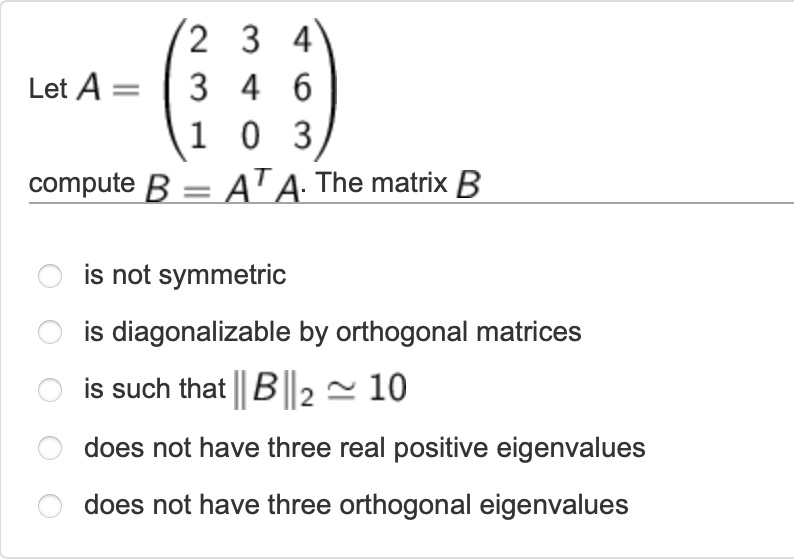
The question asks us to analyze the properties of a given matrix B.
First of, we can find the matrix B by using basic MATLAB code.
clear all
A = [2 3 4; 3 4 6; 1 0 3];
B = A'*A
ans =
B =
14 18 29
18 25 36
29 36 61With this information, we can analyze given statements in the question.
In option A, it is said that matrix B is not symmetric which means matrix B does not equal to its transpose but as we saw from the matrix B, it is symmetric so option A is false.
In linear algebra, a square matrix B is said to be diagonalizable if it can be written in the form B = PDP’, where P is an orthogonal matrix and D is a diagonal matrix. In option B, it is said that the matrix B is diagonalizable by orthogonal matrices which means that we can find an orthogonal matrix P and a diagonal matrix D such that B = PDP’. In the context of the given matrix B, we know that B is symmetric. For symmetric matrices, it is always possible to diagonalize them using orthogonal matrices. This property is known as the Spectral Theorem for Symmetric Matrices so option B is True.
In option C, it is said that the matrix norm of B, is approximately 10. We can find this by using MATLAB code after creating matrix B, norm(B, 2) so in this case it is 97,2442, approximately 100. Therefore, the option C is false.
In option D, it is said that the matrix B does not have three real positive eigenvalues. However, based on the given matrix B, we can find that all its eigenvalues(by using eig(B) code) (approximately 0.0037, 2.7521, 97.2442) are real and positive. Therefore, the option D is false.
In option E, it is said that the matrix B does not have three orthogonal eigenvalues. This option implies that the eigenvalues of B are not mutually orthogonal. To determine whether this is true, we need to calculate the eigenvectors of B. However, the given information does not provide us with the eigenvectors. Therefore, we cannot conclude whether B has three orthogonal eigenvalues or not.
Correct answer is B.
- Q3 -
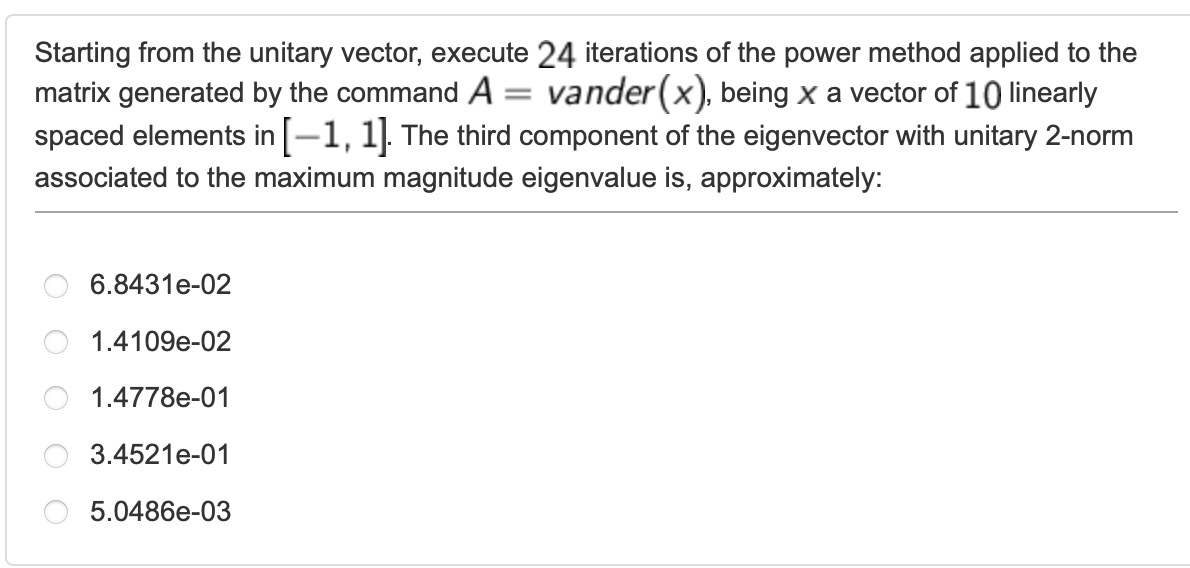
The question asks us to use the Power Method for 24 iterations on a Vandermonde matrix A generated from a vector x with 10 equally spaced elements between -1 and 1. We need to find the approximate value of the third component of the eigenvector associated with the largest eigenvalue in terms of magnitude.
clear all
x=linspace(-1,1,10);
A=vander(x);
z=ones(10,1);
w=z/norm(z);
for i=1:24
z=A*w;
lambda(i+1)=w'*z;
w=z/norm(z);
end
w(3)In the first part of the MATLAB code, it creates a vector x with 10 equally spaced points between -1 and 1 using the linspace function.
Then, it generates a Vandermonde matrix A using the vector x. Each column of the matrix A is formed by raising the corresponding element of the vector x to a power.
Then, z is initialized as a column vector of ones, and w is obtained by normalizing z. The purpose of this is to initialize w as a starting vector for an iterative process called the Power Method, used to find the dominant eigenvalue and eigenvector of a matrix.
Then, we use for loop to run 24 iterations of the Power Method. In each iteration, it updates the vector z by multiplying matrix A with the vector w, then it calculates the Rayleigh quotient lambda(i + 1), which represents an approximation to the dominant eigenvalue of matrix A, using the current vector w and the updated vector z. The vector w is then updated as the normalized version of z.
Finally, the code outputs the third element of the vector w. Since the Power Method aims to find the dominant eigenvector of the matrix A, the third element of w represents an approximation to the corresponding component of the dominant eigenvector.
Correct answer is 1.4778e-01, in this case, C.
- Q4 -
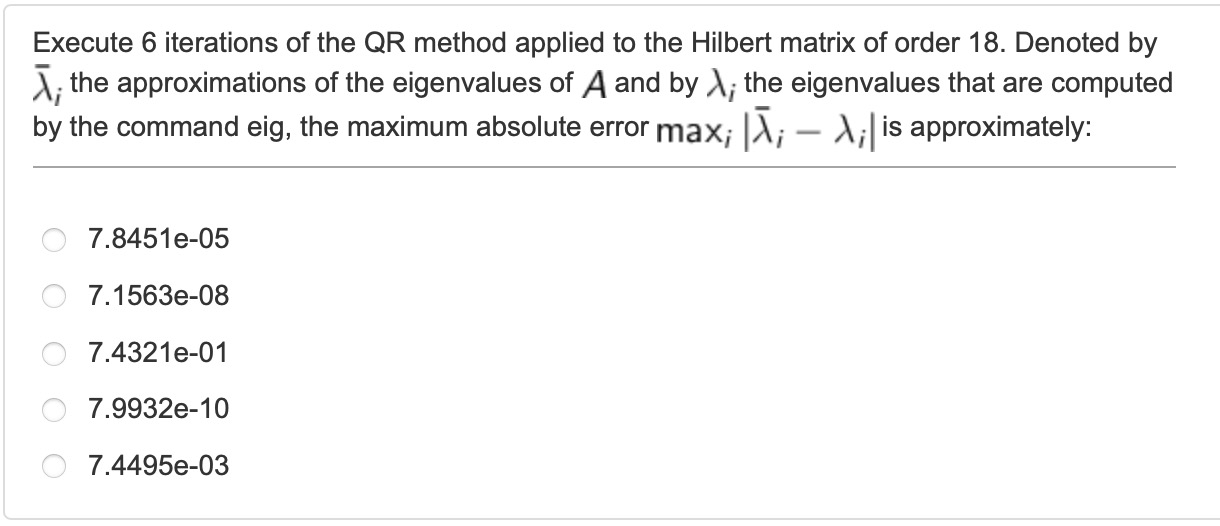
The question asks us to use the QR method iteratively for 6 iterations on the Hilbert matrix of order 18. The objective is to approximate the eigenvalues of the matrix using this method. Then, we need to calculate the maximum absolute error between the approximated eigenvalues and the actual eigenvalues obtained from the eig command. The error is measured as the maximum absolute difference between corresponding eigenvalues.
clear all
A=hilb(18);
for i=1:6
[Q,R]=qr(A);
A=R*Q;
end
max(abs(diag(A)-eig(A)))In the first line, it generates the Hilbert matrix of order 18 using the hilb function.
Then, the for loop iterates 6 times and applies the QR factorization method to the matrix A. In each iteration:, the qr function decomposes matrix A into its QR factors, Q (orthogonal matrix) and R (upper triangular matrix). The updated matrix A is obtained by multiplying R and Q together.
In the last line of code, diag(A) returns a column vector containing the diagonal elements of matrix A. These diagonal elements correspond to the approximated eigenvalues obtained from the QR method after the specified number of iterations.
By subtracting eig(A) from diag(A), the code calculates the differences between the approximated eigenvalues (diag(A)) and the actual eigenvalues (eig(A)). The max(abs(...)) function then calculates the maximum absolute difference among these differences, providing an estimate of the maximum absolute error in the eigenvalue approximation.
Correct answer is 7.1563e-08, in this case, B.
- Q5 -
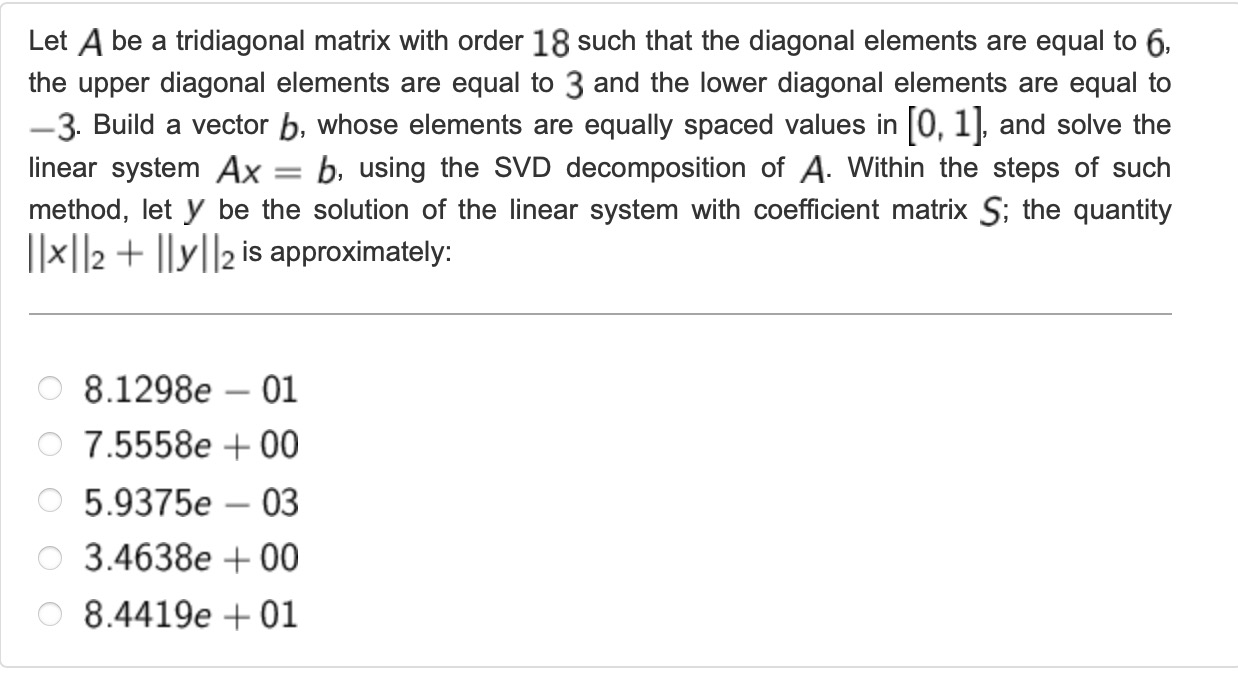
The question involves solving a linear system Ax = b, where matrix A is a tridiagonal matrix and vector b has equally spaced values. The SVD (Singular Value Decomposition) method is used to solve the system.
clear all
n = 18; % order of the matrix
A = diag(6*ones(n,1)) + diag(3*ones(n-1,1), 1) + diag(-3*ones(n-1,1), -1);
b = linspace(0, 1, n)';
[U, S, V] = svd(A);
y = inv(S) * (U' * b); % also works S \ (U' * b)
x = V * y;
norm(x, 2) + norm(y, 2)First we defined matrix A as a tridiagonal matrix of order 18, with diagonal elements equal to 6, upper diagonal elements equal to 3, and lower diagonal elements equal to -3. Vector b is constructed with equally spaced values in the range [0, 1].
Then we used svd function which is computes the singular value decomposition of matrix A. The output consists of three matrices: U, S, and V. U and V are orthogonal matrices, and S is a diagonal matrix containing the singular values of A.
The equation Ax = b is solved by multiplying the pseudo-inverse of A, given by inv(S) _ (U’ _ b), with b. The resulting vector y represents the solution of the linear system with the coefficient matrix S. Then, the solution vector x is obtained by multiplying V with y.
Finally we calculate the quantity x_2 + y_2 by using norm function.
Correct answer is 8.1298e-01, in this case, A.
- Q6 -
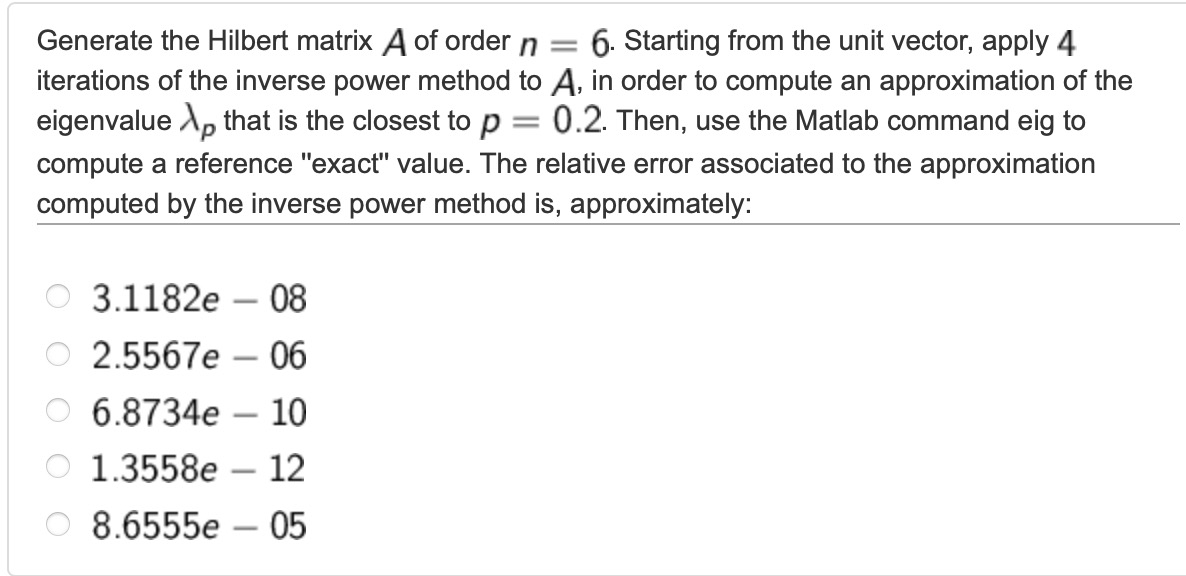
The question asks us to perform certain calculations using the Hilbert matrix, the inverse power method, and the eig command in MATLAB.
Inverse Power Method: The inverse power method is an iterative algorithm used to approximate eigenvalues of a matrix. It relies on the fact that the eigenvector corresponding to the smallest eigenvalue of the matrix A is approximately the limit of the sequence (A - pI)^(-k) * x, where p is an approximation to the desired eigenvalue, I is the identity matrix, k is the number of iterations, and x is the initial unit vector. By applying this iterative process, we can approximate the eigenvalue λ_p that is closest to the value p=0.2. Each iteration involves solving a linear system of equations.
LU decomposition is used in the provided code to solve a system of linear equations efficiently. In the context of the inverse power method, LU decomposition helps in solving the linear systems that arise during each iteration of the method. By utilizing LU decomposition, the question is solved the linear systems (A - pI)x = y during each iteration of the inverse power method more efficiently than direct methods like Gaussian elimination. This helps in improving the overall performance and computational efficiency of the code.
Computing the reference “exact” value: To validate the result obtained from the inverse power method, the eig command in MATLAB can be used. This command computes all eigenvalues of a given matrix A, and we can then select the eigenvalue that is closest to the desired value p=0.2.
clear all
n=6;
A=hilb(n);
p=0.2;
z=ones(n,1);
w=z/norm(z);
lambda(1)=p;
[L,U,P]=lu(A-p*eye(n));
for i=1:4
y=inv(L) * P*w; % also works y = L \ P*W
z=inv(U) * y; % also works z = U \ y
lambda(i+1) = p+1 / (w'*z);
w = z / norm(z);
end
approximated_val = eigs(A,1,p);
error = abs ( lambda(i+1)-approximated_val ) / abs( approximated_val )First we define our order(n) and hilbert matrix. Then we use inverse power method, initializes p to the desired value (0.2), sets up the initial vector z as a vector of ones, and normalizes it to get w.
It performs LU decomposition of A - p * eye(n) using the lu function, obtaining the lower triangular matrix L, upper triangular matrix U, and permutation matrix P.
The inverse power method is applied iteratively for four iterations. In each iteration:
The equation L _ y = P _ w is solved using forward substitution to obtain y.
The equation U * z = y is solved using back substitution to obtain z.
The updated eigenvalue estimate is stored in lambda by adding p to the reciprocal of the dot product of w and z.
w is then updated by normalizing z.
Then the code uses the eigs function to compute the eigenvalue closest to p for the matrix A, specifying that it should find the eigenvalue with the smallest magnitude (1).
The resulting eigenvalue is assigned to approximated_val as the reference “exact” value.
Finally, the absolute difference between the estimated eigenvalue (lambda(i + 1)) obtained from the inverse power method and the computed eigenvalue (approximated_val) is divided by the absolute value of approximated_val to calculate the relative error.
Correct answer is 2.5567e-06, in this case, B.
- Q7 -
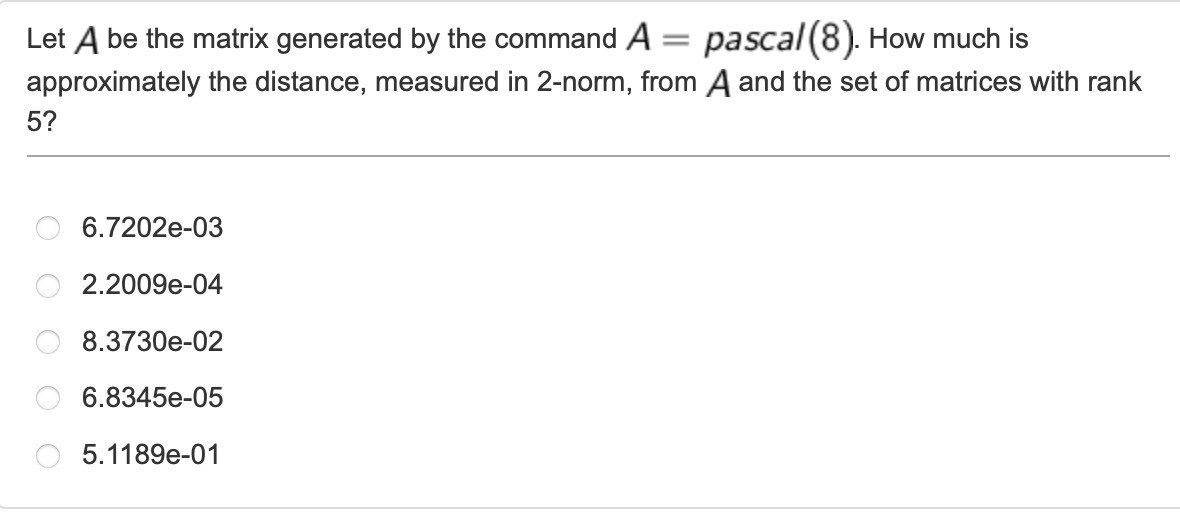
The question asks us to calculate the approximate distance, measured in the 2-norm, between the matrix A generated by the command A = pascal(8) and the set of matrices with rank 5.
The first thing we need to do is to generate the Pascal matrix of order 8 using the command A = pascal(8). The Pascal matrix is a specific type of matrix where each element is the binomial coefficient of its row and column.
Then we need to calculate the set of matrices with rank 5 using Singular Value Decomposition (SVD). The Singular Value Decomposition (SVD) is a matrix factorization technique that decomposes a matrix into three matrices: U, S, and V. For a given matrix A, the SVD is represented as A = U _ S _ V’, where U and V are orthogonal matrices (U’U = V’V = I) and S is a diagonal matrix containing the singular values of A.
In this case, we want to find the set of matrices with rank 5. By performing the SVD on matrix A, we can extract the singular values and vectors that represent the importance of each dimension in A. The singular values in the diagonal matrix S are sorted in descending order, indicating their relative significance. By keeping only the first five singular values and their corresponding singular vectors, we can construct a matrix A_rank_5 with rank 5.
After obtaining the singular value decomposition (A = U _ S _ V’), we truncate(cut) the matrices U, S, and V to only include the information related to the first five singular values. By multiplying the truncated matrices, U(:, 1:5), S(1:5, 1:5), and V(:, 1:5)’, we obtain the reconstructed matrix A_rank_5 with rank 5.
The purpose of this is to create a matrix that retains the most significant components of the original matrix A. By using only the first five singular values and their corresponding singular vectors, we effectively reduce the rank of the matrix to 5 while capturing the essential features of the original matrix.
By calculating the distance between the original matrix A and the reconstructed matrix A_rank_5, we can measure how far they are from each other in terms of the 2-norm. This distance provides an indication of how well the rank-5 approximation represents the original matrix. It allows us to quantify the loss of information or the approximation error between the two matrices.
clear all
A = pascal(8);
[U, S, V] = svd(A);
A_rank_5 = U(:, 1:5) * S(1:5, 1:5) * V(:, 1:5)';
distance_2_norm = norm(A - A_rank_5, 2)Correct answer is 8.3730e-02, in this case, C
- Q8 -

First of all, let’s analyze the question. Let x be a vector made of 10 equally spaced elements in the interval [0,1] which means the vector x contains 10 values that are evenly spaced between 0 and 1.
The command A=vander(x) generates a Vandermonde matrix using the vector x. A Vandermonde matrix is a special type of matrix where each column is formed by raising the corresponding element of the input vector to a power. In this case, each column of A will contain powers of the elements in vector x.
Our goal is to construct a new matrix An that is as close as possible to matrix A, but with a rank of 7. The rank of a matrix represents the maximum number of linearly independent rows or columns it contains.
The question mentions measuring the distance between matrices using the 2-norm measure. The 2-norm of a matrix is calculated by taking the square root of the sum of the squares of its elements. However, in this case, we need to clarify what is meant by “closest” and how it relates to the 2-norm measure.
The question also asks for the infinity norm of matrix An. The infinity norm of a matrix is the maximum absolute row sum of the matrix. In other words, it measures the largest value obtained by summing the absolute values of the elements in each row of the matrix.
clear all
x = linspace(0, 1, 10);
A = vander(x);
[U, S, V] = svd(A);
An = U(:, 1:7) * S(1:7, 1:7) * V(:, 1:7)';
norm(An, inf)The code starts by generating a vector x using the linspace function. The linspace function creates a linearly spaced vector of 10 elements between 0 and 1.
Then, it generates a Vandermonde matrix A using the generated vector x with the vander function. Each column of A is formed by raising the corresponding element of x to a power.
Then, it applies the Singular Value Decomposition to matrix A using the svd function. SVD decomposes A into three matrices: U, S, and V.
Then, it performs a low-rank approximation of the matrix A by selecting the dominant singular values and vectors. It achieves this through the following steps:
- U(:, 1:7) selects the columns 1 to 7 from the matrix U, corresponding to the dominant singular vectors.
- S(1:7, 1:7) selects the top-left 7x7 block from the matrix S, which includes the dominant singular values.
- V(:, 1:7) selects the columns 1 to 7 from the matrix V, corresponding to the dominant right singular vectors.
Multiplying these three matrices together, U(:, 1:7) _ S(1:7, 1:7) _ V(:, 1:7)’, produces the low-rank approximation matrix An.
Finally, it calculates the infinity norm of the matrix An using the norm function with the argument inf. The inf argument specifies that the infinity norm should be computed.
In the given code, SVD is used to compute the dominant singular values and vectors of the Vandermonde matrix A. These dominant components are then used to construct a low-rank approximation matrix An. By using SVD, we can effectively analyze the structure of A and derive a reduced-rank approximation, which can be useful in various applications such as data compression, noise reduction, and dimensionality reduction.
Correct answer is 1.0000e+01, in this case, E.
- Q9 -

The question is asking us to perform 8 iterations of the QR method on the Hilbert matrix of order 12, starting with matrix A₀ = A. The Hilbert matrix is a specific type of matrix where its entries are given by the formula A(i, j) = 1 / (i + j - 1).
The QR method is an iterative numerical algorithm used to find the eigenvalues (and eigenvectors) of a matrix. In each iteration, the matrix A is decomposed into a product of an orthogonal matrix Q and an upper triangular matrix R. The resulting matrix R is then multiplied by Q to obtain the updated matrix A for the next iteration which is A = R*Q in MATLAB.
The question specifically asks for the approximate value of element A₈(3,3) after 8 iterations of the QR method. This means we need to perform the QR iterations as described above and retrieve the value at the third row and third column of the resulting matrix A after 8 iterations.
clear all
format long e
A = hilb(12);
for i=1:8
[Q, R] = qr(A);
A = R*Q;
end
A(3,3)First line creates a 12x12 Hilbert matrix and assigns it to the variable A. The hilb function generates the Hilbert matrix based on the specified order, in this case, 12.
The for loop performs 8 iterations of the QR method. In each iteration, the qr function decomposes matrix A into an orthogonal matrix Q and an upper triangular matrix R. The updated matrix A is obtained by multiplying R and Q. This process is repeated 8 times, as indicated by the loop.
Last line retrives the value at the third row and third column of the resulting matrix A after 8 iterations of the QR method.
Correct answer is 4.47e-02, in this case, C
- Q10 -
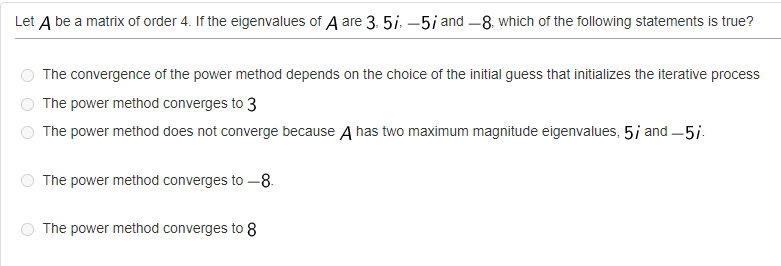
In this question, we are given a matrix A of order 4, and the eigenvalues of A are 3, 5i, -5i, and -8.
The power method is an iterative algorithm used to find the dominant eigenvalue and its corresponding eigenvector of a matrix. It relies on the observation that if you repeatedly multiply a vector by a matrix and normalize the result, it will converge towards the eigenvector associated with the dominant eigenvalue. The algorithm assumes that the matrix has a dominant eigenvalue, meaning an eigenvalue with the largest magnitude.
For option A, “The convergence of the power method depends on the choice of the initial guess that initializes the iterative process.”
-The convergence of the power method does not depend on the choice of the initial guess that initializes the iterative process. The power method is designed to converge to the dominant eigenvalue regardless of the initial guess, as long as the matrix has a dominant eigenvalue.
-The power method relies on the repeated multiplication of a vector by the matrix, normalizing it at each iteration. This iterative process gradually aligns the vector with the eigenvector corresponding to the dominant eigenvalue. The convergence behavior depends on the matrix itself, particularly its eigenvalue distribution, rather than the initial guess.
For option B, “The power method converges to 3.”
-This option is false. The power method converges to the dominant eigenvalue, which is the eigenvalue with the largest magnitude. In this case, the eigenvalue with the largest magnitude is -8, not 3.
For option C, “The power method does not converge because A has two maximum magnitude eigenvalues, 5i and -5i.”
-This option is false. While it is true that matrix A has two eigenvalues with the same maximum magnitude (5i and -5i), the power method can still converge in such cases. It converges to the dominant eigenvalue, which is the eigenvalue with the largest magnitude. In this case, the dominant eigenvalue is -8.
For option D, “The power method converges to -8.”
-This option is true. As explained earlier, the power method converges to the dominant eigenvalue, which is the eigenvalue with the largest magnitude. In this case, the dominant eigenvalue is -8. Therefore, the power method converges to -8.
For option E, “The power method converges to 8.”
-This option is false. The power method converges to the dominant eigenvalue, which is the eigenvalue with the largest magnitude. In this case, the dominant eigenvalue is -8, not 8.
Correct answer is D.
- Q11 -
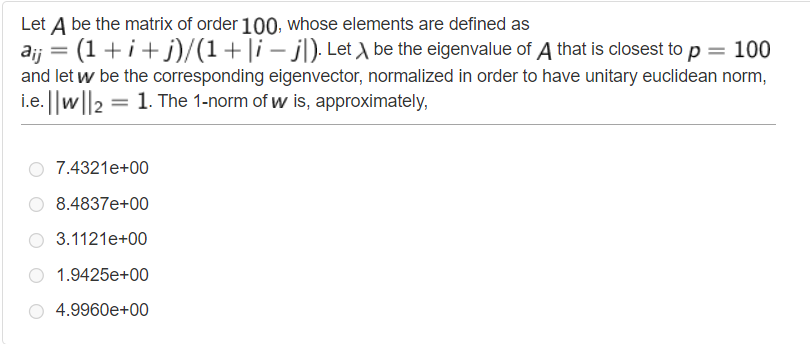
The question asks us to perform calculations on a given matrix A and find the 1-norm of a specific eigenvector.
The matrix A is of order 100, meaning it is a square matrix with dimensions 100x100. The elements of A are defined using the formula a_{ij}=(1+i+j)/(1+abs(i-j)), where i and j are the row and column indices, respectively.
Our task is to find the eigenvalue of A that is closest to p=100. An eigenvalue of a matrix is a scalar value that, when multiplied by its corresponding eigenvector, gives back the same vector. In this case, we need to find the eigenvalue that is closest to p=100.
Once we find the closest eigenvalue, we are asked to find the corresponding eigenvector and normalize it such that its 2-norm (Euclidean norm) is equal to 1.
Finally, we need to calculate the 1-norm of the normalized eigenvector. The 1-norm of a vector is the sum of the absolute values of its elements.
clear all
n = 100;
A = zeros(n);
for i=1:n
for j=1:n
A(i,j)=(1+i+j)/(1+abs(i-j));
end
end
p=100;
[z,D]=eigs(A,1,p);
w=z/norm(z);
format short e
norm(w,1)In the MATLAB code, first we have defined our order(n) and an empty matrix A with zeros(100). Then we defined the matrix A with given formula inside of a for loop.
Then we set p to 100, which indicates the desired number of eigenvalues and eigenvectors to be computed.
Then we used eigs function which is used to calculate the eigenvalues and eigenvectors of matrix A. The function call eigs(A, 1, p) indicates that we want to compute one eigenvalue/vector pair, and the value of p is used as a parameter to guide the selection of the eigenvalue. The function returns two outputs: z and D.
zis a column vector representing the eigenvector corresponding to the computed eigenvalue. It is the solution of the eigenvalue problem.Dis a diagonal matrix containing the computed eigenvalues. Since we requested only one eigenvalue/vector pair, D will be a 1x1 matrix with the computed eigenvalue.
By using this syntax ([z, D]), we assign the computed eigenvector to the variable z and the computed eigenvalue to the variable D. This allows us to access and use these values later in the code.
The eigenvector z obtained from the eigs function is normalized by dividing it by its 2-norm, computed using the norm function. This step ensures that the resulting eigenvector w has a Euclidean norm of 1.
Finally, the norm function is used to calculate the 1-norm of the normalized eigenvector w. The norm is computed by summing the absolute values of its elements.
Correct answer is 8.4837e+00, in this case, B.
- Q12 -
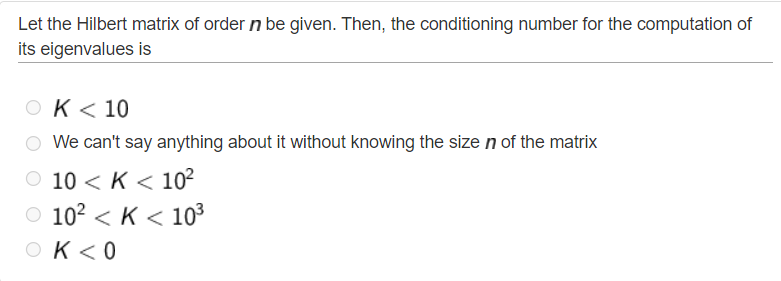
The question is related to the conditioning number of the Hilbert matrix of order n and its eigenvalues. The Hilbert matrix is a specific type of matrix that has entries defined as H(i,j) = 1 / (i + j - 1), where i and j are the row and column indices, respectively.
The conditioning number measures the sensitivity of a problem to changes in its input. In this case, it refers to the sensitivity of computing the eigenvalues of the Hilbert matrix to perturbations or errors in the matrix.
The Hilbert matrix is well-known for being ill-conditioned, meaning that small changes in its entries can lead to large changes in its eigenvalues. However, the specific value of the conditioning number (K) depends on the size (order) of the matrix.
For small values of n (order of the matrix), the Hilbert matrix has a relatively low conditioning number. As n increases, the conditioning number grows rapidly, indicating increased sensitivity to perturbations.
However, without knowing the size n of the matrix in the given question, we cannot determine the exact conditioning number. Therefore, the most conservative assumption we can make is that K<10, implying that the conditioning number is less than 10.
This assumption is based on the fact that for small to moderate values of n, the conditioning number of the Hilbert matrix tends to be less than 10. It allows for a more general and cautious statement without relying on specific matrix sizes.
Correct answer is A.
- Q13 -
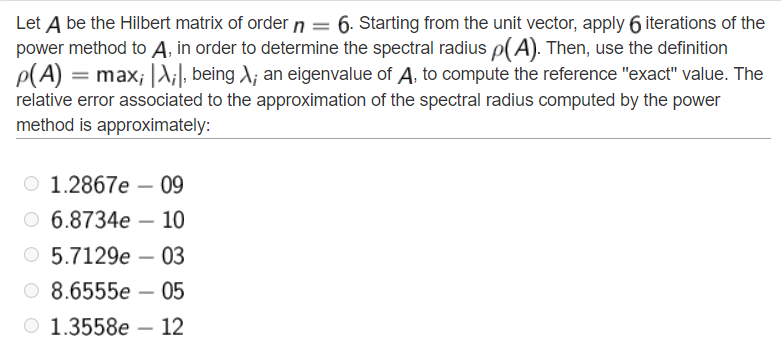
The question asks us to determine the spectral radius of a Hilbert matrix of order 6, denoted as A, using the power method. The power method involves iteratively multiplying a vector by A, normalizing it, and repeating this process several times. After 6 iterations, the resulting vector is used to estimate the dominant eigenvalue and the spectral radius. The question also asks us to compute the exact value of the spectral radius using the definition ρ(A)=max(i)abs(λ(i)), where λ(i) represents an eigenvalue of A. Finally, we are required to calculate the relative error associated with the approximation obtained from the power method.
clear all
n=6;
A=hilb(n);
z=ones(n,1);
w=z/norm(z);
for i=1:6
z=A*w;
lambda(i)=w'*z;
w=z/norm(z);
end
approximated_val=eig(A);
radius1=max(abs(approximated_val))
radius2=max(abs(lambda));
err=abs(radius1-radius2)/abs(radius1)In the code, it sets the value of n to 6, which represents the order of the Hilbert matrix. Then, sets A=hilb(n) which generates the Hilbert matrix A of order n.
Then, initializes the vector z as a column vector of ones with length n. This vector is used as the initial unit vector.
Then, it normalizes the initial unit vector z by dividing it by its norm. This creates the initial vector w, which is used in the power method.
Then, the loop for i=1:6 performs 6 iterations of the power method. Inside the loop, z=A*w multiplies the matrix A with the vector w, resulting in a new vector z. lambda(i)=w'*z calculates the approximation of the dominant eigenvalue by taking the dot product of w and z. This value is stored in the array lambda for each iteration. w=z/norm(z) normalizes the new vector z, producing the updated vector w for the next iteration.
After the loop, approximated_val=eig(A) computes all the eigenvalues of matrix A and stores them in the array approximated_val. radius1=max(abs(approximated_val)) finds the maximum absolute value among the eigenvalues of A, giving the approximate value of the spectral radius. radius2=max(abs(lambda)) finds the maximum absolute value among the values stored in the array lambda, which represents the eigenvalues estimated by the power method.
Finally, err=abs(radius1-radius2)/abs(radius1) calculates the relative error.
Correct answer is 1.2867e-09, in this case, A.